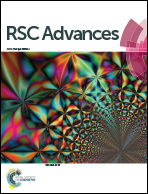Fabrication of a high density graphene aerogel–gold nanostar hybrid and its application for the electrochemical detection of hydroquinone and o-dihydroxybenzene†
Abstract
Graphene aerogel materials have attracted increasing attention owing to their large specific surface area, high conductivity and electronic interactions. In this study, we report for the first time a new strategy for the fabrication of a high density graphene aerogel (HDGA) through a simple multiple gel method. The results show that the density of HDGA will rapidly increase with increasing number of graphene oxide gelation cycles. The as-prepared HDGA exhibits a better mechanical strength and electrochemical property than common graphene aerogel. Interestingly, these properties are easily adjusted by controlling the number of graphene oxide gelation cycles. To further improve the electrocatalytic performance, gold nanostars were synthesized and modified on the surface of graphene sheets. The hybrid was successfully developed as a sensing material for the electrochemical detection of hydroquinone and o-dihydroxybenzene with ultrahigh sensitivity and selectivity. The study also opens an avenue for the design and synthesis of various graphene aerogel materials to meet the needs of further applications in sensing, catalysis and energy storage/conversion device.


 Please wait while we load your content...
Please wait while we load your content...